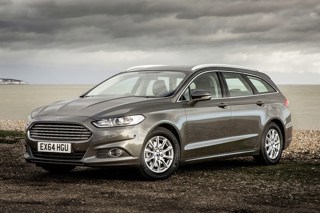Review
At Paris motor show Mr Nasser stressed his confidence in Ford of Europe chairman Nick Scheele and his colleagues. Now the team must start turning the business round.
After cost cutting exercises earlier this year new Mondeo “is the start of the second stage”, according to Ian McAllister, Ford of Britain chairman.
At the press launch of Mondeo in France, Mr McAllister repeated a company pledge to launch “45 new or heavily revised vehicles in the next five years”.
The new Mondeo is designed to bridge the gap between the outgoing model and the Scorpio, dropped by the company two years ago because of poor sales. Compared with the previous car, it is 150mm (6 inches) longer overall, and 50mm longer in the wheelbase.
New Mondeo is larger and better equipped than the car it replaces in order to satisfy the demands of customers downsizing from larger models. Ford said medium saloon buyers are now looking for “the package, quality and features offered by an executive car”.
Mr McAllister said: “Everybody would like to buy a bigger car if they could afford it. New Mondeo offers them that opportunity. This is a very difficult marketplace. Buyers are becoming more knowledgeable and more demanding.”
Mondeo is not radical but, according to Mr McAllister, “it defines the class. Even politicians refer these days to 'Mondeo man'”. The outgoing car was the top seller across the C and D sectors for the past five years and achieved more than 750,000 sales in the UK. It was the No1 seller in the fleet market until recently.
With the fleet market in mind, Ford has worked hard on cost of ownership. The new Mondeo has better fuel economy, lower insurance ratings and a 12,500-mile service interval common across both petrol and diesel engines.
Ford engineers are particularly pleased with the new direct injection diesel engine which, they claim, uses virtually no oil between services.
There is a strong safety message too. The original Mondeo was the first car in the class to offer an airbag as standard – new Mondeo has six. It is also equipped with an “intelligent protection system” which includes crash severity sensors to control the sequence and type of deployment of the airbags; a driver's seat position sensor and a passenger sensor.
Paul Mascarenas, Mondeo chief project engineer, said the model was designed and built to Ford's new DCDQ mantra – dependable, contemporary, driving quality. It is powered by two new Duratec engine ranges, one petrol and one diesel. The petrol engines are 1.8-litre 125bhp, a 2-litre 145bhp unit and the existing 2.5-litre 170bhp unit. The diesel engines are both 2.0-litre, 16-valve, direct injection units with a choice of 90bhp or 115bhp with a turbocharger.
Next year Ford will launch a common rail diesel with around 135bhp which will top the range. The company admitted it had “underestimated customer expectations in the diesel market” and was working hard to close the gap. By 2004 it plans to have developed a full range of common rail diesels as a result of its collaboration with PSA Peugeot Citroen.
Trim levels for the new Mondeo will be LX, Zetec, Zetec S, Ghia and Ghia X. Air conditioning, electric front windows, heated front windscreen and remote boot unlocking are standard across the range.
The Mondeo will be launched at the Birmingham motor show as a 5dr hatchback and 4dr saloon. The estate car, which is expected to account for around 20% of sales, will follow in January. Ford will not discuss prices ahead of the launch.
Factsheet
No information available.














Login to comment
Comments
No comments have been made yet.